I was excited to be invited to present to DevOps and engineering folks at the O’Reilly Velocity Conference in Santa Clara, 2015. I opened the talk with an example of bringing someone in to give you a different way of seeing your problem. A Practical Type of Empathy (27 minutes) Transcript below.
Transcript: A Practical Type of Empathy
Hi everybody, I’m going to start with a little story.
I’m building a stone patio in my backyard. Last weekend, I was supposed to pick out a grout color. Apparently, this is a very difficult thing. I just wanted a brown grout color. I looked at all the cards. There’s all these browns. Which one do I want? I can’t figure it out from the cards, so I make up some samples of these grouts. And there were seven samples. Six of them were brown. One of them was gray, because the stones also have a little gray in them. I’m sitting there looking at them and I’m like, “Oh my God, this is the most difficult thing I’ve had to do all month. This is crazy. How am I going to pick this color out?” I need somebody else to give me a little bit of input.
Lucky for me, my neighbors happen to be artists. They may not have a lot of experience with grout per se, but they have a lot of experience with color. So I run over there; I go grab them and I bring them back. I say, “Hey, look at these.” They both immediately point to one brown. They said, “This is it. This brown brings out the beautiful brown color in the stone. It actually goes with your house. If you look at these other brown colors, those are red. You don’t have any red in this house. Those are purple. You don’t have any purple.” I’m looking at them. Purple? Red? Oh, I can see those now. They’re like, “The gray is too flat.” I’m starting to learn all this stuff about color that I couldn’t think of by myself. This is just a little story about bringing someone in to give you a different way of seeing your problem.
I assume you guys have done something similar in your own lives. You have a problem that you’re up against, and you walk over to a co-worker’s room. You get in front of the whiteboard, and you start explaining what the problem is. (Nod your head if you’ve done this before.) As you’re explaining it, you’re talking about all the little details. He’s asking you some questions about it. You’re coming up with a different way of explaining it, and then suddenly, “There’s an idea! This thing pulls it all together! This is the solution. This is how I can do it. Thank you so much.”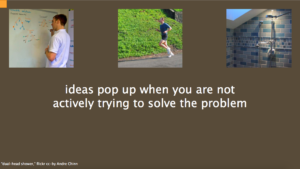
It may not have been something that he said or it may have been something that he said. It was just that whole practice of doing the explanation. This is actually a really well known phenomenon, it turns out. Well-studied. Creativity, or coming up with ideas, is very easy when you aren’t trying to actually solve a problem right at the moment. So when you’re in front of the whiteboard explaining it to somebody, when you’re relaxing on your evening run (a lot of people tell me that) or when you’re in the shower. (This is where I always come up with ideas. I need a whiteboard in the shower, seriously.) I’m sure some of you guys know where you come up with ideas and can think of some additional ones. This is just a truism about creativity and ideas. It’s that if you relax your brain, then things will work out. If you want to at work increase the number of ideas that you’re coming up with, it’s a great idea to bring more people in to help you see the problem differently.
Now, if you solicit that additional input from people, I’m going to show you how it works. This is your brain. These are the ideas that are popping out of it. These ideas are all based on the cognition that you’ve been doing about the problem and about the solution. Therefore, all of your ideas are bounded by that problem and that solution. Make sense?
If you want to break outside of that frame, if you want to reframe it a little bit, bringing other people’s thoughts into you is what is going to vastly increase the number of ideas that come up. Now, these ideas may not be specifically about the problem. They may just be a different parallel thing that you’re thinking about, but it causes your brain to be able to come up with ideas that are better for your problem solving.
It also allows you to discover things that you totally didn’t realize before, something brand new. It also helps you validate ideas that you weren’t totally certain about. This is just the way that your brain works. The idea is really to get as many outside people giving you ideas, giving you input, giving you new ways to look at a problem. This is going to vastly increase your own creativity, your own ability to solve the problems.
How do you do this? It turns out that empathy is the mechanism to do this. You’re like, “Really? Empathy seems to be the answer to everything these days.” You hear about this left and right. You hear about it in the media. Back before it was a buzzword, you might have been willing to look into it and think about what empathy really means. But now that everybody is talking about it, it’s like, “Yeah, what? Do they think we’re all a bunch of replicants? Are they going to start giving us Voight-Kampff empathy tests at work now?” Nooooo. (Which of course might not be such a bad idea for our politicians. This guys gave Gavin Newsom an empathy test, Voight-Kampff, and it didn’t really turn out so well. He got very suspicious.)
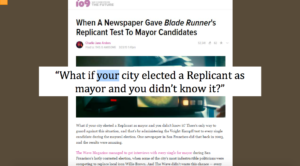
I want to give you a little run down about some of the articles where they’re trying to talk about empathy as being the panacea for everything. Here is an example from the Harvard Business Review. In it, the author has some very good points, but defines empathy this way, as “becoming truly responsive to your customers and their needs, and also to the needs of your employees.” Responsive is the word that they’re using to define empathy here. In this Forbes article, they’re talking about empathy as “the ability to connect with and relate to others.” So far, we’ve got responsive and we’ve got relate. Then we’ve got this HuffPo article, where he’s talking about successful leaders and decision makers. The point he’s making is that they have humility and compassion.
So what is the message being sent by these articles about that buzzword empathy? It’s that empathy is “be more sensitive.” Be more emotionally aware. If empathy equals emotional sensitivity, then how in the world are you going to apply that at work? How does that work? This is the question I want to answer for you guys today.
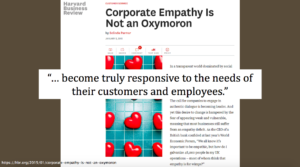
It turns out that sensitivity is just one kind of empathy. I want to define a few of these kinds of empathy for you. When I was doing the research for my book, it turns out in the psychology literature there’s about eight kinds of empathy out there. I’m only going to tell you about four. These are the more common ones I suppose. It’s really helpful to understand these different kinds of empathy especially when you start hearing other people using empathy as that buzzword.
The first one I’m going to talk about is called mirrored empathy. Neuroscientists say, this is still controversial, but they say that when you see the facial expression of someone or their hand movements, neurons that are similar in your brain start to fire, and emotional transference occurs. Here is an example. Let’s say you’re walking down the street, busy street. You see somebody smiling and making eye contact with you, and you find yourself smiling automatically in response. Has that ever happened to you? Maybe your mood lifts a little bit. And the opposite could happen. Maybe you’re driving in traffic, and there is some dude with road rage. You can see him snarling at you through the windshield, and your heart rate comes up. You start getting a little angry too. Mirrored empathy. You can start to identify it in your own world.
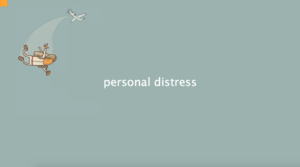
A second kind of empathy is called personal distress. As that word implies, it’s when you see somebody who’s having something bad happen. You get the sharp, momentary feeling of what it would be like to be in that same situation. For example, someone jumps out of a plane and can’t pull the chute. Or more domestically, maybe you’re watching somebody in the kitchen chop up vegetables, and she slices her finger. (Hiss) You’ve done that. This is called personal distress.
The third kind of empathy is effective empathy. Affective empathy is all about feeling the same emotion that another person is feeling. The word affective actually means emotional, so you can call this emotional empathy. That’s how I call it in my book, a little bit easier to remember than the psychology word. With emotional empathy, this is along the lines of like your friend calls you and says, “Oh, hey, I got that job.” You’re like, “Ah!” You feel the happiness, right? Maybe someone’s depressed, and you’re starting to feel their depression. This is also how actors and authors convey characters to you. By helping you understand how that character is emoting, they give you a much deeper sense of what the story is going on. So, within a book or a movie, if you don’t understand what the character is feeling, with emotional empathy, you’re losing half of that whole picture. Next time you watch a movie, if you watch one tonight even or if you go read a book tonight, think about this. Think about how much of the characters are all about the emotion.
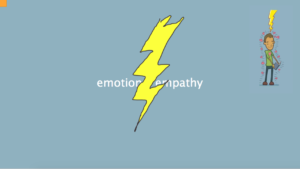
Like a bolt of lightning, feeling what someone else is feeling is extremely illuminating and very powerful. This is why you’re getting emotional empathy as a buzzword. I think this is what most of those articles are actually talking about with being able to relate to other people. Unfortunately, like a bolt of lightning, you can’t make it happen when you want it to happen. So it’s not something that’s repeatable. And when it’s not repeatable–I mean, it’s great when it happens at work, and you can understand things so much more deeply–but really if you can’t make it happen, it’s not something you can use at work. It’s something you can take advantage of when it happens, but you can’t use it or apply it. If you want to use something in your work, it needs to be reliable and repeatable, so that you can take the information that you get from this and apply it to the ideas that you’re trying to bring up. It also needs to have some structure and viable purpose.

So … enter cognitive empathy. Whoops, I forgot this slide. I love this slide actually. This is the thing that I run into a lot when I go work with my clients is that, when they think about the word empathy, when they think of it as an emotional transference or as a personal distress or emotional empathy, they say, “Ah, that’s just a bunch of fluff. Nice to have.” But bunnies and rainbows; this is not going to help us.
What we need is something called cognitive empathy. Cognitive empathy is all about understanding what went through the mind of a person and their reactions. It’s just basically finding out what was going through that person’s head as they worked toward a particular purpose or intent. This is not in general, but it is in specific. So, if you ask somebody about going to the airport, you can’t get answers about like, “Oh, when I go to the airport, I blah, blah, blah,” which is a generalization. You can only develop cognitive empathy by asking them about the last time they went to the airport or a memorable time. And they were up against an event that happened, and here is how they fought their way around it.
So, of the four kinds of empathy that we have on the screen, mirrored empathy, personal distress, emotional empathy, and cognitive empathy, cognitive empathy is the one that’s viable in your work because you can make it repeat. It’s the mechanism by which you can increase the number of ideas. This is the whole point. This is what we want to do, is make these ideas broader, so that we can get some new things going on.
It is repeatable because when you and when someone else maybe listen to or hear or read the same set of words, you can get the same meaning out of it. You can get that same meaning over and over again, and you can take those meanings and build them up into a structure which I’ll show you in a little bit. When you get multiple people that you’ve been looking at and developing empathy with, you can start to see patterns across those people as well, which are extremely useful in the generation of new ideas.
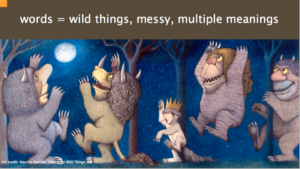
People go, “Yeah right. I don’t believe you, because words are unreliable.” People when they speak, they speak in a messy way. They say things one way, and then they say things another way, and they play with their words. There’s multiple meanings, and everything is open to interpretation. So, “Indi, I don’t believe you.” I have to give in to that point at the surface. The surface is the way that we normally have conversations with each other every day. We’re like, “How do you do this? Where did you put the peanut butter? Could you help me figure this thing out? I don’t think that’s the right thing to do. Could you stop doing that.” Those kinds of things. These are all at the surface. These types of things are opinions, preferences, statements of fact, explanations, how to do things, or what happened, or how things are. Maybe you’re trying to help somebody learn something. These are all usually affected by the mood the person is in, by the context of what the person is talking about, and also by the person that they’re speaking to. So the person they’re speaking to actually affects what they’re telling you. They change their story from person to person. This at the surface is not reliable. You cannot necessarily create cognitive empathy from the surface, but you can from the depth.
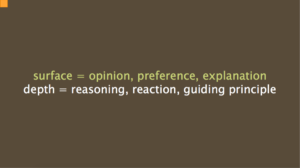
If you go deeper and you find out actually what the reasoning was, how are those neurons firing in that brain, not necessarily chemically but what were the thoughts running across the surface of your brain? What were the reactions you were having? What are the guiding principles and the philosophies that you developed to help you make decisions over time and to motivate yourself? These are the things that are at a more of a depth. And these are the things that are reliable and clear. You can derive the exact same meaning from them time after time after time.

If I can just repeat that, at the surface, you’re not able to develop cognitive empathy. Preferences, opinions, nope. But down at this lower level, the inner voice, that little voice that you hear as you’re making decisions, that’s the thing that you can develop empathy with–that inner landscape.
If you do this maybe for a project to understand not the problem that you are creating a solution for, and not the solution itself but the whole world in which a person is working toward a particular intent or purpose–not necessarily reaching for your solution or not. If you do that, you can do summaries of everything that you hear, and start to see these patterns. You can let these patterns build from the bottom-up inductively, not deductively. And when you add more and more voices, you get stability. You get something that is solid and that will be true because it’s human thinking for decade after decade after decade.
Very interesting, I’ve helped lots of companies start this process, and then they keep adding to this process year after year after year building the structure up. Interestingly, you can create a structure in a diagrammatic format that will help you pinpoint gaps in your thinking about your solution. And it will help you brainstorm those new ideas and bring out those new ideas in a very focused way, helping you support the various towers [patterns] of how people think.
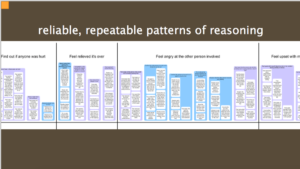
So, if you want to broaden those ideas for the project, you want to broaden the number of people you bring in to help you see the problem differently. Simple equation.
Another way of looking at it is this is our typical development cycle, think, make, check. Anybody familiar with this? There’s lots of different ways of writing this up. This is a simple one. In think, you do your brainstorming about a solution. You do some little version of it. You throw it in front of somebody, and you see if it supports that person. Is it supporting that person well enough or not? If not, you go back to the drawing board. You brainstorm more things. You make it again. You throw it front of the person again. This is all cycling around the solution. It’s all cycling around the idea of the specific thing that you’re making.

What I suggest to people is that you have a separate cycle running, which is cycling not around the thing that you’re making, but is cycling around people–people in general. This is actually the cognitive empathy development cycle. This is where you are understanding how people are thinking with their little inner voices. How they are achieving the intent and how they’re getting there, and what are those guiding principles are along the way.
Then the part of it that affects the first cycle is the brainstorming. This is how you filter these ideas into your solution cycle. This is different than the traditional way of saying that we’re going to frame this around “user needs.” We’re not talking about a user; we’re talking about a person. We’re not talking about needs; we’re talking about what’s going through their head. This is very different. This is all because I don’t want you to keep just whirling around in that first cycle that’s focused on the thing that you’re building. I want you to get outside of that. This other thing can roll at a much slower pace, like I said, once a year. Fine. And just let it influence. But so long as you’re getting those additional perspectives, then you’re broadening the idea set that you can make.
One more thing I want to tell you about empathy is when you say that word all by itself, you automatically think, “Ah, it’s about walking in somebody’s shoes.” It’s about trying to figure out how that person would act and react in a certain scenario. And that’s true and very powerful, and it’s all about applying empathy. The thing is, most people apply empathy based on guesses and assumptions about what was going through someone’s head. They skip entirely the development stage. You have to develop empathy before you can apply it.
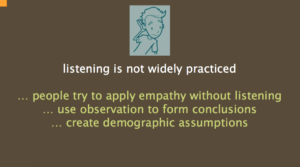
How do you develop empathy? For cognitive empathy, you have to listen. We don’t have telepathy servers yet. (Somebody better work on that, I hope.) Until then, you have to listen. Or get people to write you long essays explaining all the little thoughts that went to their head, and that little inner voice and inner landscape. Listening is the step that a lot of people skip, and listening is a part of that separate cycle that I’m trying to get people to do. It’s one-on-one listening. It’s not a group thing. It’s you sitting down with one other person, and respecting that other person no matter what they say, even if what they say is completely wrong. It’s their way of thinking about it. Get behind the opinions. Find out how they formed. Find out how the preferences formed. Get all of that guiding principle stuff so that you can develop cognitive empathy.
By the way, those last four slides were actually from my workshops and practice sessions. I actually never do my listening sessions face to face. I always do them by phone. And I do it for a reason, because for me, it helps to have the other person unpack their brain while not looking at my face and trying to elicit reactions from me or be fearful of reactions from me, and afraid to say something to me. It’s a great way to be able to reach out to a broader and broader numbers of people to understand how they think, and influence your own ideation.
I want to do a quick example of what happens when you don’t spend time listening. You’ve got this. You’re making your assumptions. There’s a Berkeley researcher called Paul Piff. He did a study about the science of greed, he called it. He put a pedestrian in a crosswalk, and he noted down which makes a car stopped and let the pedestrian cross, and which makes of cars did not stop. He concluded that people who are wealthy enough to drive fancy cars didn’t feel like they had to stop for pedestrians. He didn’t bother to talk to the drivers and find out what they were thinking. He didn’t even bother to find out if the driver was actually the owner of the car. What he was doing is he’s basing his conclusions on a bunch of assumptions that were derived from pure observation. Observation is not enough, because of that thing about not having telepathy servers yet. (We need those.) He also, at least the way he wrote his conclusions, went up against this rule that we all learned in the university, correlation is not causation. What he is saying in his conclusion is that the fact that I am driving an expensive car causes me not to stop for a pedestrian. So, next time you have a chance to rent a fancy car, maybe you could experiment with this and drive around, and see if you don’t stop for pedestrians. Anyway, that’s a great example so that you have something to throw out there.
This is all over the media. Sadly, listening is really not widely practiced. Here are some of the things that I’ve mentioned. People try to apply empathy without first listening. People use observation alone to form their conclusions. They create demographic assumptions based on these conclusions. Meaning, because you’re of this demographic, you behave that way. Correlation is not causation.
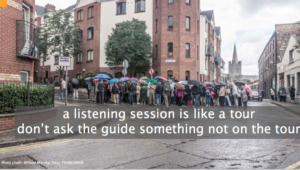
One last thing before I go. A listening session, I wanted to show you how to do it super quick. It’s just like going on a tour. Everybody been on a tour in a foreign city? I’m assuming, yeah? When you go on a tour or you’re following that tour guide around listening to what she has to say about the history and the people, and the things that happened here, and maybe a bit about this building here. And you don’t interrupt her just because you see that church down the street, and you’re a big fan of architecture. You let that person tell you what’s on her agenda. That’s exactly what you do in a listening session. You let that person tell you everything that’s going through their mind because it’s their agenda.
This is all about being able to increase the number of ideas that are coming out because you’re bringing in other people to have new ways of looking at your problem, so the idea is to just stuff your brain as much as possible.
I’ve written a book that just got released called Practical Empathy. And if you’re into that structure stuff that I showed you, my first book is called Mental Models, and that’s all about that. I want to thank you so much.

